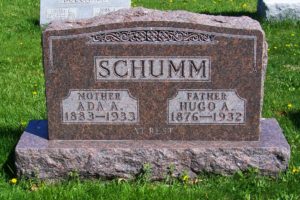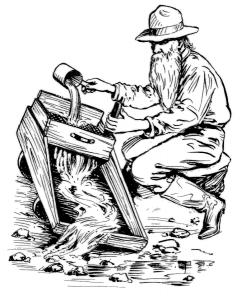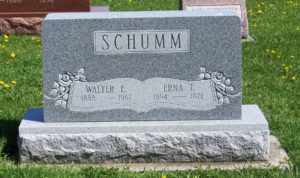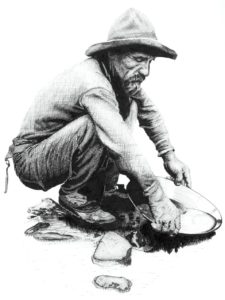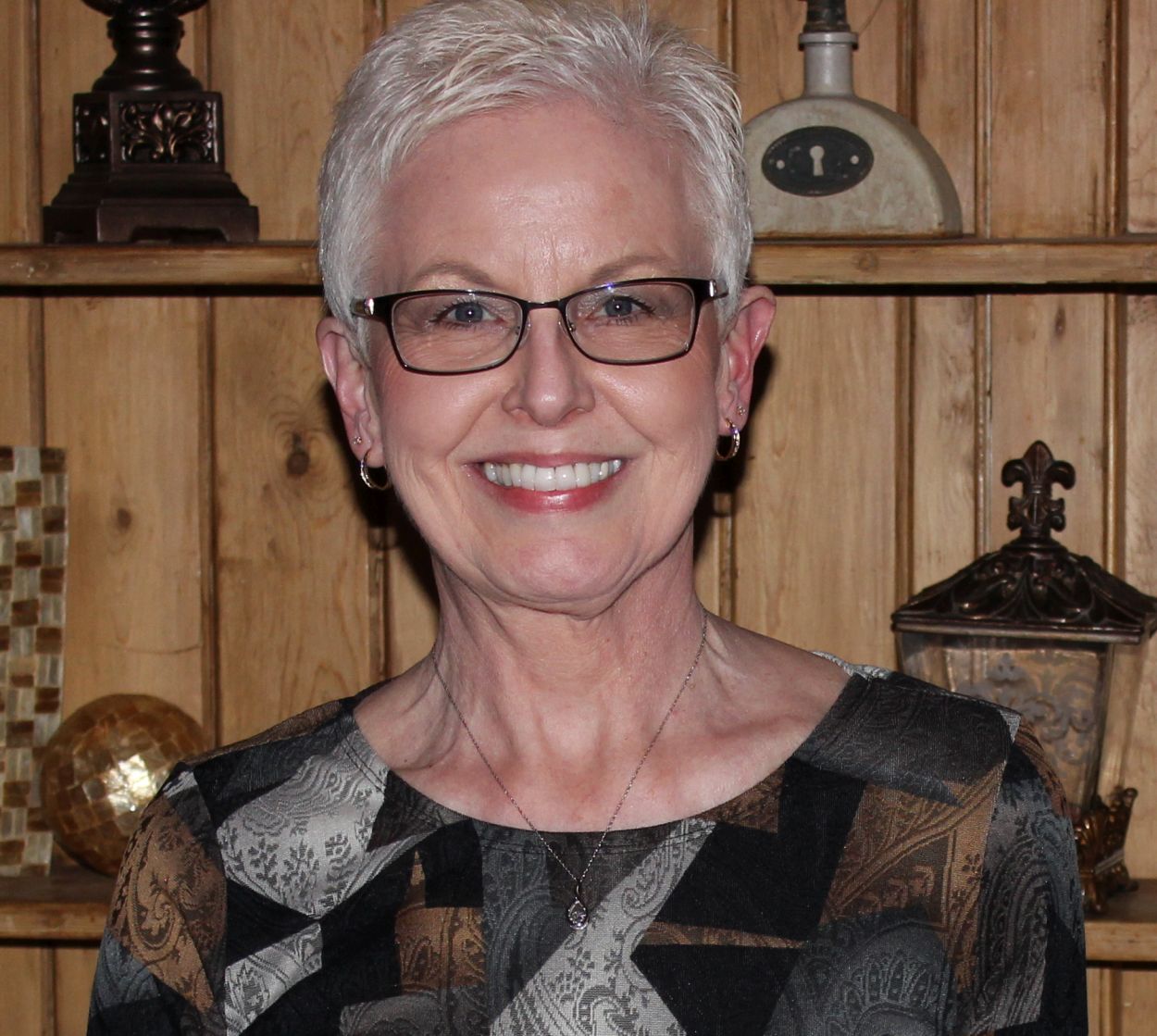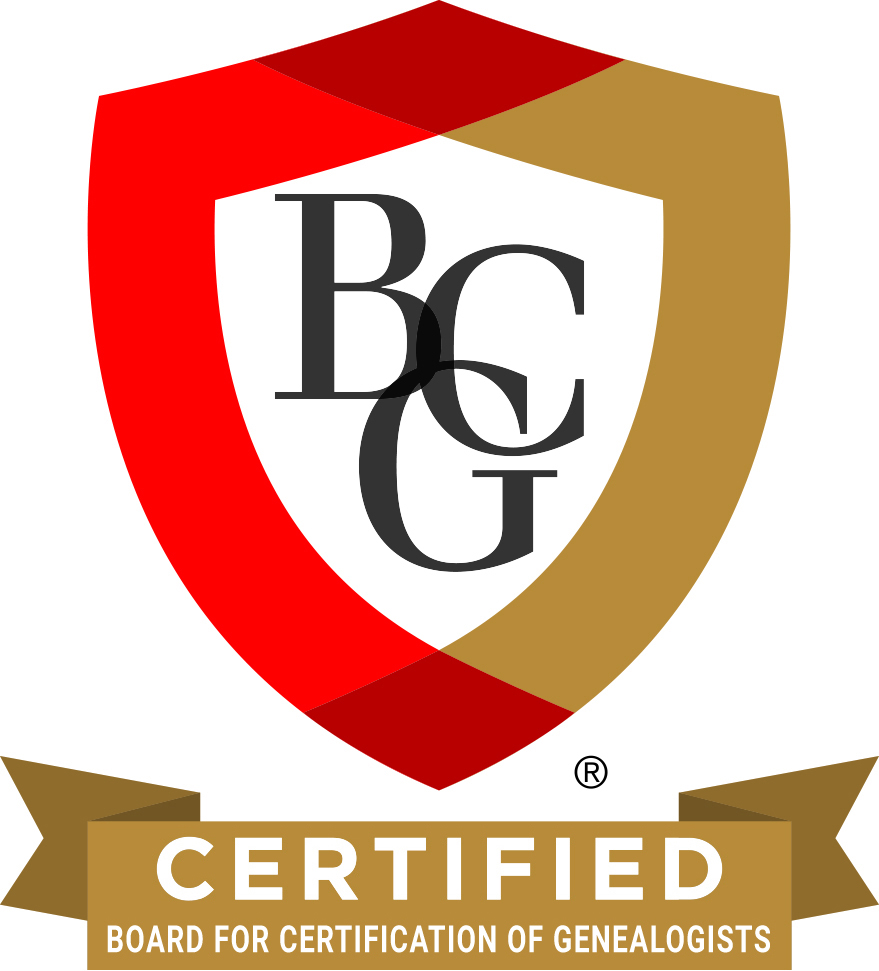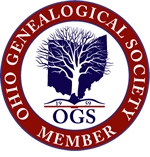Today’s blog post is the nineteenth in a series, the transcription of Nimrod Headington’s 1852 journal, Trip to California.
In his journal Nimrod Headington details his 1852 voyage from New York to San Francisco and his search for gold in California. [1] [2]
Nimrod, with several others from Knox County, Ohio, set sail from New York on 16 February 1852, traveling on the clipper ship Racehound. After 5 months at sea they docked at San Francisco on 18 July 1852.
In today’s blog post, Nimrod continues his search for gold in California in mid-January 1853. We learn that panning for gold was not easy. Nimrod was living day to day, barely making a go of it. The heavy snow in the mountains made the search for gold difficult. And he came in contact with some interesting characters. Would Nimrod ever find gold?
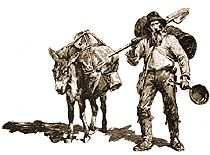 The next day we went to work again with our spirits at a low ebb, but when we cleaned up our sluice, we had $17. Then the water began to come in on us so that we could not get to bedrock. There was where the principal part of the gold lay. Our tail race was not deep enough to drain the water down to bedrock. The snow was then 10 foot deep and packed down solid so that it was impossible for us to dig it any deeper until the snow went off. It was 14 foot from the surface of the ground to the bedrock, then 10 foot of snow on top of that made 24 foot underground.
The next day we went to work again with our spirits at a low ebb, but when we cleaned up our sluice, we had $17. Then the water began to come in on us so that we could not get to bedrock. There was where the principal part of the gold lay. Our tail race was not deep enough to drain the water down to bedrock. The snow was then 10 foot deep and packed down solid so that it was impossible for us to dig it any deeper until the snow went off. It was 14 foot from the surface of the ground to the bedrock, then 10 foot of snow on top of that made 24 foot underground.
The next morning we went to the claim again, but the water was backed up all over the claim, and we had to give it up for that day.
The next day we went to getting wood again, as we could not get employment and were determined to stay there if we could keep from starving. We were then pretty hard up. We were living on beans and potatoes, without any bread or meat, and they were getting very scarce.
Saturday, January 22nd, one of us succeeded in getting employment and the rest kept on getting up wood. It was a slow and hard job, as the snow was 10 foot deep, and the crust was not stiff enough to bear us up all the time. Sometimes we would go through with a heavy load of wood on our backs and go down to our armpits.
Sunday, January 23. Almost a year has now elapsed since I left my home and little family, and I am a poorer man than when I started. My money all gone, and I am in debt. And I have worked hard and went ragged, and now I am almost reduced to want for food for my body and clothing for my body. If ever I thought of the comforts of home and kind friends, it is this day. We spent most of the day in washing and drying our clothes.
January 24th. This morning about one hundred of the miners got together and formed a company to undertake to break a road to the Lexing House, a distance of twelve miles, in order to get the mule trains in with provisions, as it was impossible for them to get in unless there was a road broke for them. Charles Watkins, one of my partners, went to assist in breaking the road. John Huey and myself succeeded in getting work that day, for which we got five dollars each. Our employment was chopping wood, while the man that employed us hauled it on a hand sled.
January 25th. The mail came in, and I made my way to the post office, thinking surely I would hear from home, as I had not had a letter for five months, but I was disappointed, and this made me feel pretty blue.
January 26th. This day Mr. McCafferty and I went to work shoveling snow off of a pile of dirt that we had thrown out before the snow fell. We were working close to a cabin occupied by a Mr. Cosgrove and his wife and a man by the name of Campbell, who was a notorious drunkard and had been on a spree for two weeks or more. All of a sudden, we heard the screams of a woman. On looking, I saw Mrs. Cosgrove with both hands up to her face and screaming as loud as she could. I dropped my shovel and ran to her to see what was the matter. When I reached the cabin, I found Mr. Campbell stretched out on the floor and the blood gushing from his throat. He had cut his throat. The razor was still in his hand. A doctor was soon on hand, but there was no help for the fellow. He had done a good job—cut off the jugular vein and the swallow more than half off.
January 29th. Last night there was ten head of beef cattle drove in—the first four-footed animals that had come into the diggings for more than two months. A serious accident happened about a mile from our claim. Today a man by the name of Philo Watkins was working under a large snowbank when all of a sudden the snow gave way and fell on him and killed him instantly.
January 30th. Sunday went around and settled up with those for whom we had worked during the week, and we had fifty-eight dollars between us on that day. Jesse Watkins, one of my partners, concluded to leave. So he packed up his blankets and started. Charles Watkins and John Huey, my other two partners, started to Poker Flats to get provisions—a distance of eight miles.
They returned just at dark, bringing 75 lbs. of flour, 20 lbs. of rice, and 6 lbs. of sugar. We then felt that we were good for another week. [3]
To be continued…
I will post Nimrod’s journal in increments, but not necessarily every week.
[1] Nimrod Headington at the age of 24, set sail from New York in February 1852, bound for San Francisco, California, to join the gold rush and to hopefully make his fortune. The Panama Canal had not been built at that time and he sailed around the tip of South America to reach the California coast. Nimrod Headington kept a diary of his 1852 journey and in 1905 he made a hand-written copy for his daughter Thetis O. Tate. This hand-written copy was eventually passed down to Nimrod’s great-great-granddaughter, Karen (Liffring) Hill (1955-2010). Karen was a book editor and during the last two years of her life she transcribed Nimrod’s journal. Nimrod’s journal, Trip to California, documents his travels between February of 1852 and spring of 1853.
[2] Nimrod Headington (1827-1913) was the son of Nicholas (1790-1856) and Ruth (Phillips) (1794-1865) Headington. He was born in Mt. Vernon, Knox County, Ohio, on 5 August 1827 and married Mary Ann McDonald (1829-1855) in Delaware County, Ohio, in 1849. Nimrod moved to Portland, Jay County, Indiana, by 1860 and during the Civil War served in the 34th Indiana Infantry as a Colonel, Lieutenant Colonel, and Major. Nimrod died 7 January 1913 and is buried in Green Park Cemetery, Portland. Nimrod Headington is my fourth great-granduncle, the brother of my fourth great-grandfather, William Headington (1815-1879).
[3] Nimrod Headington’s journal, transcription, and photos courtesy of Ross Hill, 2019, used with permission.

